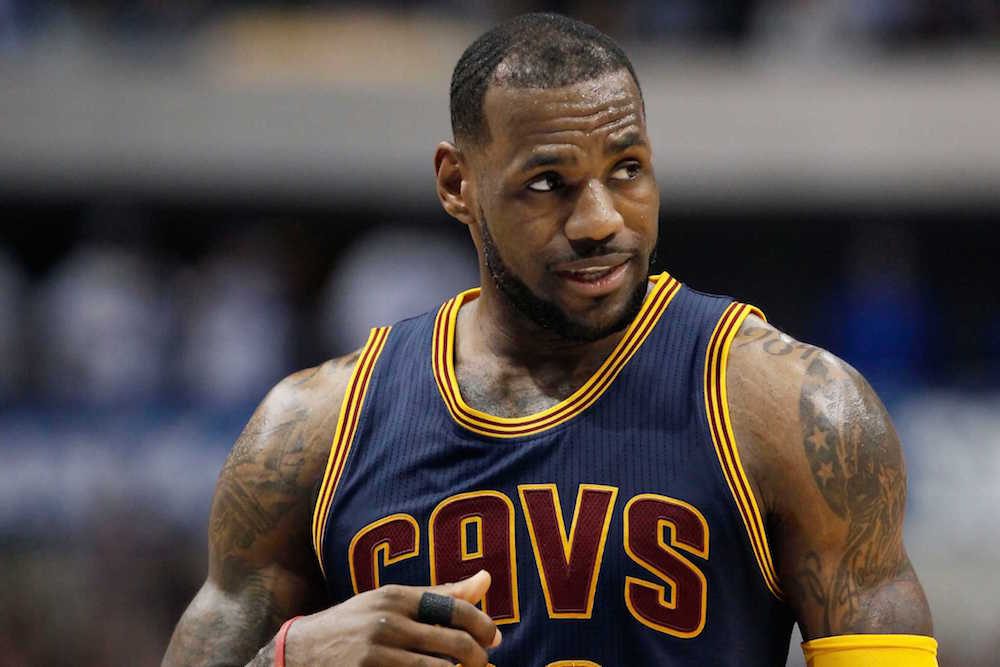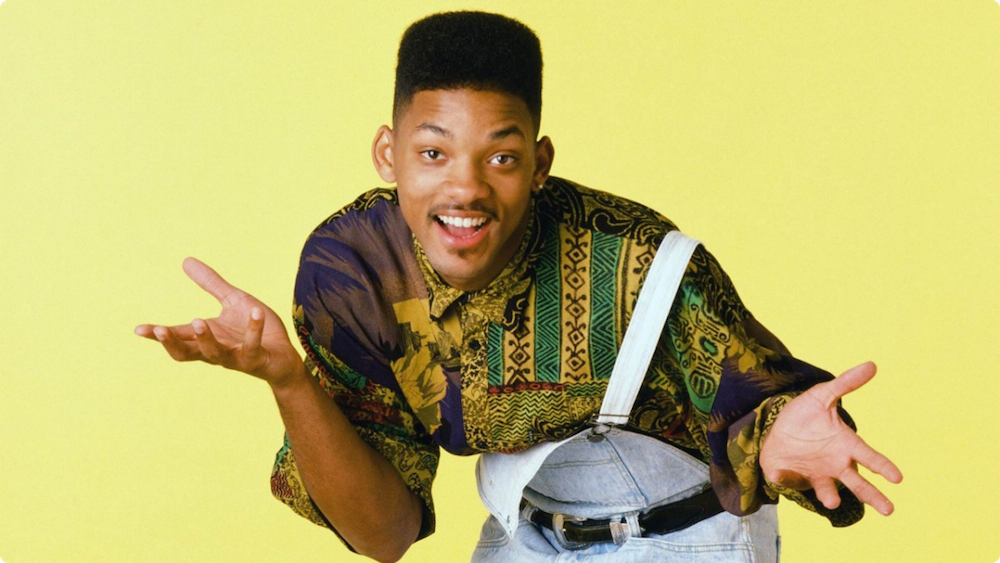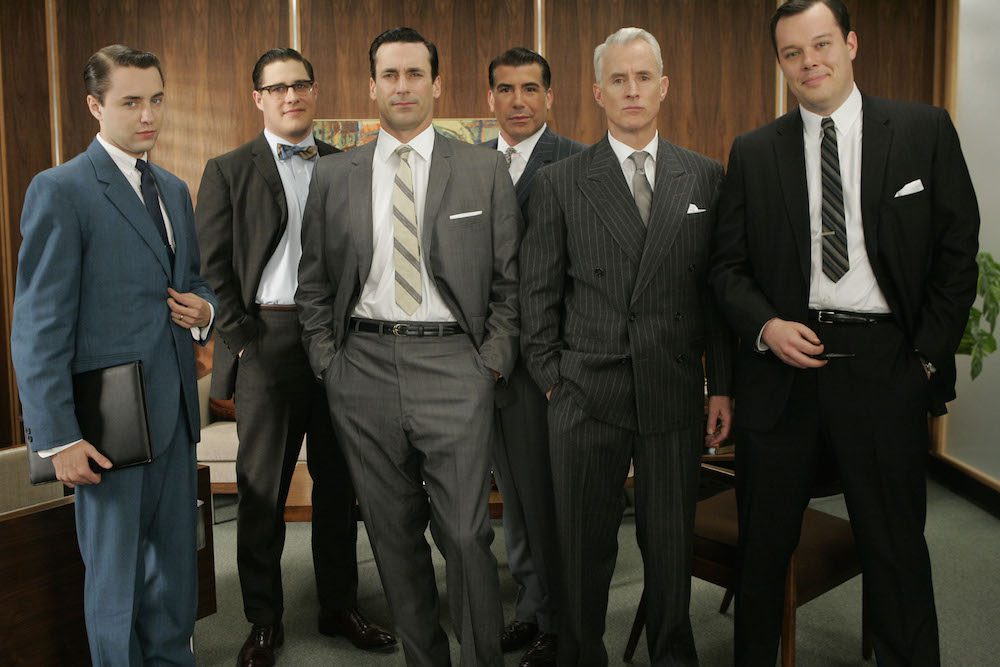Talking Shop
Nick Stillman and Alphonse Smith, friends and co-workers at the Arts Council New Orleans, meet over beers and basketball to talk barbershops, race, and masculinity.

Lebron James playing for the Cleveland Cavaliers. PHOTO BY BRANDON WADE. COURTESY ASSOCIATED PRESS.
(Half-watching a basketball game.)
Alphonse Smith: All you’d hear about for a while was how LeBron’s headband was getting bigger and bigger throughout the years. This great athlete was so insecure about his balding and how his hairline would make the horseshoe shape. If you’re a black dude, and you have the horseshoe thing going on, you’ll get ribbed.
Nick Stillman: Really! (laughter)
AS: Yeah, like if your hairline is crooked or way back or whatever, you stand in danger of getting ribbed. He’s not wearing the headband now and says it’s because he wants to look like his teammates in Cleveland. I think he’s finally like, “You know what? I’m LeBron James. I’m going to own it.” A barber probably took his line up to make it look more square and he’s just a little more confident now. You can see he’s got some lines in his hair, real stylish.
NS: At what point in your life did you become aware of having to take care of your hairline?
AS: Oh man, you’re always aware. I’m the third of eight kids and we grew up all over New Orleans. The first person who gets a crack at your head—when you’ve got eight kids and six boys—is your pops. My pops could not cut hair. He would mess my lining up. But he tried. My two oldest brothers really worked to keep themselves up and spent a lot of money on the newest clothes and on haircuts. So there was a precedent of style set by them. My second-oldest brother had an S-Curl at one time—kind of high fade on the side like I have now but with activator and curl. I remember him being in the bathroom and putting perm stuff in his hair, and you can’t wait too long ’cause it’ll burn your scalp. So he had this infatuation with style and started practicing.
NS: Practicing cutting your hair?
AS: Yup. Eventually he got really good at it. Even so, not having the textbook barbershop haircuts, I had to face a gallery, man! You could get away with it in elementary school, but not junior high. I went to a junior high school that was notorious for ribbing, Fannie C. Williams. Notorious. Kids are mean-hearted anyway, and if you don’t look right. So in the black community I was raised in, you become conscious of style very young.
NS: When you were young did you have a signature haircut or was it always changing because of different family members cutting your hair?
AS: When I was growing up, the typical cut was a fade. So this is like mid-80s through mid-90s. In the ’80s the hip-hop influence was big, which of course went into the ’90s. So this black voice emerges with regard to style.
NS: Is that the general era where you feel like the concept of hip “black style” hit the American mainstream?
AS: Yeah. You’d see rappers on MTV—Will Smith with the high-top fade, Kid ’n Play. Once you put anything on blast like that, everyone wants to be the best at it. So you’d see all these new styles: fade, high-top fade, low-top fade, the Gumby hairstyle, the Pappadeaux, lines all through the hair, parts, the bush came back into style in the ’90s with the pick and a taper fade on the sides and back.

Will Smith as the Fresh Prince of Bel-Air. Photo by CHRIS CUFFAIO. Courtesy NBCUniversal and GETTY Images.
NS: If you were to submit a picture of the one haircut in your life that you’re most embarrassed by now, what does that picture look like?
AS: There was this one haircut. This was when I was in law school at Southern. I was feeling my way around Baton Rouge, trying to find a barber who could give me a nice cut. I went to this older guy, thinking he has years of experience, right? Now, typically you’re afraid to get your hair cut by an older guy, because they’re not hip to the new styles, but I’m thinking he won’t mess up a regular cut. He cut my hair so my lining … (laughter) Do you remember the game Street Fighter? There’s a character named Balrog whose lining resembled the teeth from a Halloween pumpkin. That’s the way he lined my front. Man, I’m just happy that didn’t happen in high school. It’s better not to have a haircut than to have a bad haircut.
NS: Who’s your barber now?
AS: My barber’s name is Dwight Alexander and he cuts hair at Park Place in Gentilly. It’s a barbershop, beauty salon, and barber training school, which is very important to note. Becoming a barber is an empowering trade. Barbershops, even Southern black-owned barbershops back in the day, catered mostly to white clients. So they were still serving the same people they’d historically served. Then came a time when they could open their shops to black clients and communities, and it became a pride thing, a respectable business. The business of making your people look their best. If you’re an African-American male, looking both presentable and stylish is big.
NS: Have you ever had a woman cut your hair?
AS: No. Always wanted to.
NS: Why?
AS: I wouldn’t necessarily leave my barber. I’ve been loyal to him for about two years now. But I feel like—this is maybe bad logic—as much as a man knows about how another man should look, a female barber might have a different perspective on what looks good on a man—especially if you’re trying to look good for the ladies! (laughter) I’m kidding, but I have always wondered if there would be some difference in the type of care put into the experience.
NS: What if I told you that, for the entire time you’ve known me, my barber has been a woman?
AS: Really? I would think it’s easier for a woman barber to cut a white guy’s hair because of the similar textures.
NS: Did you hear about what happened at Aidan Gill a while back? A woman** whose style was more traditionally masculine went to this famous New Orleans barbershop to get a haircut and was denied service. It was upsetting because that was the space she identified with. In the barbershops you’ve gotten haircuts in that are primarily or exclusively black men, what would happen if a woman came in and asked for a haircut?
AS: She’d get a haircut. A lot of black women are going natural now, and you’ll see them going to male barbers to get styled.
NS: Isn’t that story disappointing? The Aidan Gill decision seems like it’s about preserving the concept of the barbershop as a sanctuary for men—heterosexual men that is.
AS: It doesn’t make sense. At the end of the day, it’s commerce. Now black barbershops can be very brutal and very political, but I haven’t heard of any situation here in New Orleans where a black barber has turned away or refused to cut a gay man’s or a woman’s hair.
NS: Is your current barber your favorite barbershop experience? And what does the perfect barbershop experience mean to you?
AS: The reason I started going to this barbershop is because it’s a black-owned business that’s a trade school as well—very professional, cool atmosphere. I went to one barbershop where a guy cut my hair awesomely, but eventually—I wasn’t afraid to go there—but from conversations I would overhear, I could tell that it might not be safe to keep going.
NS: Any possibility that was just part of the barbershop bullshitting that guys do?
AS: Not in this case. But I enjoyed that particular experience because of that barber and the other barbers clowning, talking about anything and everything. It’s nice to chop it up with the fellas. That’s what a real relationship with your barber becomes. I’d say though that my current barber is my best experience. He does a good job, nothing fancy, and he remembers exactly what I want.
NS: Memory is a huge part of how I judge a barber.
AS: Yeah. Every time he says, “Same way?” I appreciate that and they’re still fun as hell at this place—still the masculine camaraderie and arguments. I was talking to a different barber recently who asked me how I felt about a barber talking while cutting hair. It’s fine, right? He was thinking it wasn’t good customer service. The conversation is what I find endearing about a barbershop.
NS: Many women might describe a trip to the spa as an experience that can enhance a sense of one’s femininity. Would you say that’s true for you and masculinity as it relates to the barbershop?
AS: Yes. I can cut my own toenails. (laughter) And socially I’m not expected to paint my fingernails or get a manicure or whatever. So the barbershop is where I go to be pampered. Someone gives a certain amount of time and attention to how you look. Those barbers are taking just as much pride in your haircut as you are because you become their business card. So, yeah, you spend a decent amount of money, sit and wait patiently, make time out of your week to go and have this experience.
NS: What’s the most you’ve ever spent on a haircut?
AS: I spent $40 on a haircut just to skip the line once. Right now I pay $25 plus a tip.
NS: How often do you get your hair cut?
AS: Sometimes every week. Sometimes two weeks. If I have a low haircut, then more often. For what I have now, I could go two weeks and be okay.
NS: Describe your current haircut.
AS: I’m kind of letting it grow the way it’s going to grow, without combing or styling. And then I’ve got the fade. Clean bohemian? As a black man, I hadn’t given much thought to what goes into a white man’s hairstyle. What’s the theme behind a white man’s haircut?
NS: I think a lot of white guy haircuts are about survival. (laughter) What you have to work with, which can be very diverse. My hair is really thick—kind of a mop if it’s not combed.
AS: This is pretty ignorant of me, but I didn’t realize that texture would be so diverse. So, the guys on Mad Men…
NS: Right, very different hair textures, but fashioned in such a way that it stays neat and looks like it belongs to the same general theme. Professional survival communicated through hair. Pretty fascinating how much Mad Men has altered white men’s hair trends in recent years. In the current Pelican Bomb exhibition you can have your hair drawn by a cartoonist and then name your own style. I called mine “The Grandfather” because my mother is so amused that I now have exactly the same hairstyle as her father when she was growing up. My wife thought I should call it “The Don Draper.” The 1950s modernity has returned in white men’s hair fashion. It’s interesting: in New Orleans I’m seeing a lot of really individualistic haircuts on black men and an increasing homogenization of white men’s haircuts.

The MALE CAST OF MAD MEN. Courtesy AMC.
AS: Right now you have so many African-American men embracing long hair. For a while you had to have the clean look, for both social and professional reasons. I don’t think I’m growing my hair out because of this, but probably subconsciously, the professional environment I’m now in has allowed me to grow my hair. I think there is something about not having to follow corporate expectations, or hip-hop expectations, whatever the case may be. There’s actually another white-dominated trope I want to ask you about: that sort of metro-lumberjack look. Long hair, big beards but very sculpted, maybe a curled mustache.
NS: What do you make of it?
AS: I don’t know. (laughter) It’s like a merger of clean-cut and the mountain-man deal. Don’t know how to read it, honestly.
NS: Beards are an asset to the “survivor.” (laughter) They can cover up some fatal flaws. The changing of cultural norms around facial hair in recent years has been a game-changer for many white men less gifted in the facial structure department. What’s your opinion on beards?
AS: To me, growing a beard has always been a masculine symbol. It’s not about race; it’s squarely about gender.
NS: Right. It’s like there are archetypes for black haircuts and archetypes for white haircuts, but beards don’t quite operate with the same logic. You can’t predict at all how it’s going to look based on race or the texture of the hair on your head.
AS: There’s really no wrong way to have a beard. The only thing you can’t do: have a beard without a moustache.
NS: Agreed; that’s off-limits. In our father’s era, the solo mustache was the archetypical symbol of masculinity. Now, if you’re a younger white man and you have a mustache—just a mustache, no beard—there’s an assumption that it’s a period reference, like an ironization of the idea of masculinity being symbolized by some hair above your lip.
AS: Black men have a lot of leeway with facial hair. I think mustaches have become less popular in the black community, but if I could grow out a thick mustache and keep it lined and neat … yeah, maybe.
NS: That raises a point I want to talk about, which is the idea of your hair demonstrating the fact that you put some effort into it. When I grew up, in the rural Northeast, if you were a young man and your hair was very intentionally styled, that was profoundly uncool. Not making an effort, when it came to your hair, that was cool. This was a difficult mental habit to break: that making an effort on my hair was effete or embarrassing.
AS: That’s so funny. With black hair, it’s all about making an effort. Spending the money, scheduling the time, allowing someone to technician your hair. And I think this all comes from the expectation that in order to be successful you have to be clean and appear organized according to the status quo. You couldn’t get away with having dreads, or bush, or different types of styles in a corporate context until pretty recently. The rhetoric in the black community was that you’re not just going to be judged on your skills and intelligence alone, you’re going to be judged on how you look as well. So don’t threaten the status quo. I still think it’s good to put in the effort, but to do so on my terms.
Editor's Note
**The individual described in the incident with Aidan Gill does not identify as a woman and uses "person" as the chosen descriptor.



